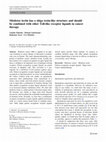Papers by Michael Linnebacher
World Journal of Immunology, 2013
Author contributions: Mullins CS, Walter A performed most of the experiments; Schmitt M, Classen ... more Author contributions: Mullins CS, Walter A performed most of the experiments; Schmitt M, Classen CF, Linnebacher M planned the study, supervised and discussed the results; Mullins CS, Linnebacher M wrote and revised the manuscript; Classen CF, Schmitt M proofed the manuscript.

Patient-individual tumor models for Glioblastoma Multiforme (GBM) are important not only for basi... more Patient-individual tumor models for Glioblastoma Multiforme (GBM) are important not only for basic and translational research but also for the development and improvement of optimal and individualized treatment strategies. The model that has gained widest acceptance is the primary cell culture model. The laborious and time consuming process is rewarded with a relative high initial success rate (about 60%). We here describe and evaluate an extended biobanking methodology to simplify sample collection and model establishment. GBM resection specimen were collected ad hoc, partially prepared fresh for modeling, snap frozen for molecular testing and frozen down vitally. The established models were subject to subsequent detailed characterization in direct comparison to the patients´ tumors. Generally, molecular characteristics such as mutations, gene amplifications and epigenetic alterations were maintained in the models. Immortality, neuronal origin and stem cell characteristics of the c...

Nature Communications, 2015
The development of molecularly targeted anticancer agents relies on large panels of tumourspecifi... more The development of molecularly targeted anticancer agents relies on large panels of tumourspecific preclinical models closely recapitulating the molecular heterogeneity observed in patients. Here we describe the mutational and gene expression analyses of 151 colorectal cancer (CRC) cell lines. We find that the whole spectrum of CRC molecular and transcriptional subtypes, previously defined in patients, is represented in this cell line compendium. Transcriptional outlier analysis identifies RAS/BRAF wild-type cells, resistant to EGFR blockade, functionally and pharmacologically addicted to kinase genes including ALK, FGFR2, NTRK1/2 and RET. The same genes are present as expression outliers in CRC patient samples. Genomic rearrangements (translocations) involving the ALK and NTRK1 genes are associated with the overexpression of the corresponding proteins in CRC specimens. The approach described here can be used to pinpoint CRCs with exquisite dependencies to individual kinases for which clinically approved drugs are already available.

Biochemical Pharmacology, 2014
Cannabinoids have been shown to promote the expression of the intercellular adhesion molecule 1 (... more Cannabinoids have been shown to promote the expression of the intercellular adhesion molecule 1 (ICAM-1) on lung cancer cells as part of their anti-invasive and antimetastatic action. Using lung cancer cell lines (A549, H460) and metastatic cells derived from a lung cancer patient, the present study addressed the impact of cannabinoid-induced ICAM-1 on cancer cell adhesion to lymphokine-activated killer (LAK) cells and LAK cell-mediated cytotoxicity. Cannabidiol (CBD), a non-psychoactive cannabinoid, enhanced the susceptibility of cancer cells to adhere to and subsequently be lysed by LAK cells, with both effects being reversed by a neutralizing ICAM-1 antibody. Increased cancer cell lysis by CBD was likewise abrogated when CBD-induced ICAM-1 expression was blocked by specific siRNA or by antagonists to cannabinoid receptors (CB1, CB2) and to transient receptor potential vanilloid 1. In addition, enhanced killing of CBD-treated cancer cells was reversed by preincubation of LAK cells with an antibody to lymphocyte function associated antigen-1 (LFA-1) suggesting intercellular ICAM-1/LFA-1 crosslink as crucial event within this process. ICAM-1-dependent pro-killing effects were further confirmed for the phytocannabinoid Δ(9)-tetrahydrocannabinol (THC) and R(+)-methanandamide (MA), a hydrolysis-stable endocannabinoid analogue. Finally, each cannabinoid elicited no significant increase of LAK cell-mediated lysis of non-tumor bronchial epithelial cells, BEAS-2B, associated with a far less pronounced (CBD, THC) or absent (MA) ICAM-1 induction as compared to cancer cells. Altogether, our data demonstrate cannabinoid-induced upregulation of ICAM-1 on lung cancer cells to be responsible for increased cancer cell lysis by LAK cells. These findings provide proof for a novel antitumorigenic mechanism of cannabinoids.
Genes, Chromosomes and Cancer, 2015

Molecular Cancer Therapeutics, 2013
The antitumorigenic mechanism of cannabidiol is still controversial. This study investigates the ... more The antitumorigenic mechanism of cannabidiol is still controversial. This study investigates the role of COX-2 and PPAR-g in cannabidiol's proapoptotic and tumor-regressive action. In lung cancer cell lines (A549, H460) and primary cells from a patient with lung cancer, cannabidiol elicited decreased viability associated with apoptosis. Apoptotic cell death by cannabidiol was suppressed by NS-398 (COX-2 inhibitor), GW9662 (PPAR-g antagonist), and siRNA targeting COX-2 and PPAR-g. Cannabidiol-induced apoptosis was paralleled by upregulation of COX-2 and PPAR-g mRNA and protein expression with a maximum induction of COX-2 mRNA after 8 hours and continuous increases of PPAR-g mRNA when compared with vehicle. In response to cannabidiol, tumor cell lines exhibited increased levels of COX-2-dependent prostaglandins (PG) among which PGD 2 and 15-deoxy-D 12,14 -PGJ 2 (15d-PGJ 2 ) caused a translocation of PPAR-g to the nucleus and induced a PPAR-g-dependent apoptotic cell death. Moreover, in A549-xenografted nude mice, cannabidiol caused upregulation of COX-2 and PPAR-g in tumor tissue and tumor regression that was reversible by GW9662. Together, our data show a novel proapoptotic mechanism of cannabidiol involving initial upregulation of COX-2 and PPAR-g and a subsequent nuclear translocation of PPAR-g by COX-2-dependent PGs. Mol Cancer Ther; 12(1); 69-82. Ó2012 AACR.

International Journal of Cancer, 1997
MAGE-2 is expressed in many tumors, including melanoma, laryngeal tumors, lung tumors and sarcoma... more MAGE-2 is expressed in many tumors, including melanoma, laryngeal tumors, lung tumors and sarcomas, but not in healthy tissue, with the exception of testis. Thus, MAGE-2derived peptides that bind to HLA class I molecules and elicit cytotoxic T lymphocyte (CTL) responses could be of significant therapeutic importance. In this study, we show that several MAGE-2-derived peptides bind with high affinity to HLA-A*0201. Three of them form complexes with HLA-A*0201 that are stable at 37°C and are immunogenic in HLA-A*0201K b transgenic mice. Moreover, CTLs against 2 of them (M2 112-120, and M2 157-166) specifically recognize cells that express both the MAGE-2 protein and HLA-A*0201K b . These 2 peptides are processed and presented in the context of HLA-A*0201. Therefore, these peptides are candidate components in peptide-based vaccines for the treatment and prevention of several types of MAGE-2expressing cancers. Int.

Cancer Immunology, Immunotherapy, 2013
Mistletoe extract (ME) is applied as an adjuvant treatment in cancer therapy in thousands of pati... more Mistletoe extract (ME) is applied as an adjuvant treatment in cancer therapy in thousands of patients each year in Europe. The main immunostimulating component of mistletoe extract, mistletoe lectin, recently has been shown to be a pattern recognition receptor ligand and hence is binding to an important class of pathogen-sensing receptors. Pattern recognition receptor ligands are potent activators of dendritic cells. This activation is a prerequisite for a full-blown T-cell response against cancer cells. Pattern recognition receptor ligands are increasingly recognized as important players in cancer immunotherapy. We collect evidence from case studies on spontaneous regression, from epidemiology, from experiments in a mouse cancer model, and from protein structure comparisons to argue that a combination of mistletoe therapy with other pattern recognition receptor ligand substances leads to an increased immune stimulatory effect. We show that mistletoe lectin is a plant protein of bacterial origin with a 3D structure very similar to shiga toxin from Shigella dysenteriae, which explains the remarkable immunogenicity of mistletoe lectin. Secondly, we show that a combination of pattern recognition receptor ligands applied metronomically in a cancer mouse model leads to complete remission, while single pattern recognition receptor ligands slowed tumor growth. Taken together, we propose to combine mistletoe drugs with other pattern recognition receptor ligand drugs to increase its efficacy in adjuvant or even primary cancer therapy.
Cancer, 2004
A novel pancreatic carcinoma cell line, FAMPAC, was identified from investigation of poorly diffe... more A novel pancreatic carcinoma cell line, FAMPAC, was identified from investigation of poorly differentiated pancreatic adenocarcinoma cells found in a patient with a familial predisposition to pancreatic carcinoma. A gene responsible for familial pancreatic carcinoma has not been identified to date.

Oncotarget, Jan 24, 2015
Expression of the human endogenous retrovirus (HERV)-H family has been associated with colorectal... more Expression of the human endogenous retrovirus (HERV)-H family has been associated with colorectal carcinomas (CRC), yet no individual HERV-H locus expression has been thoroughly correlated with clinical data.Here, we characterized HERV-H reactivations in clinical CRC samples by integrating expression profiles, molecular patterns and clinical data. Expression of relevant HERV-H sequences was analyzed by qRT-PCR on two well-defined clinical cohorts (n = 139 pairs of tumor and adjacent normal colon tissue) including samples from adenomas (n = 21) and liver metastases (n = 16). Correlations with clinical and molecular data were assessed. CRC specific HERV-H sequences were validated and found expressed throughout CRC disease progression. Correlations between HERV-H expression and lymph node invasion of tumor cells (p = 0.0006) as well as microsatellite instable tumors (p < 0.0001) were established. No association with regard to age, tumor localization, grading or common mutations beca...

PloS one, 2015
Patient-individual tumor models constitute a powerful platform for basic and translational analys... more Patient-individual tumor models constitute a powerful platform for basic and translational analyses both in vitro and in vivo. However, due to the labor-intensive and highly time-consuming process, only few well-characterized patient-derived cell lines and/or corresponding xenografts exist. In this study, we describe successful generation and functional analysis of novel tumor models from patients with sporadic primary colorectal carcinomas (CRC) showing CpG island methylator phenotype (CIMP). Initial DNA fingerprint analysis confirmed identity with the patient in all four cases. These freshly established cells showed characteristic features associated with the CIMP-phenotype (HROC40: APCwt, TP53mut, KRASmut; 3/8 marker methylated; HROC43: APCmut, TP53mut, KRASmut; 4/8 marker methylated; HROC60: APCwt, TP53mut, KRASwt; 4/8 marker methylated; HROC183: APCmut, TP53mut, KRASmut; 6/8 marker methylated). Cell lines were of epithelial origin (EpCAM+) with distinct morphology and growth ki...
World Journal of Gastroenterology Wjg, 2010
To investigate the effectiveness of Clostridium novyi (C. novyi )-NT spores for the treatment of ... more To investigate the effectiveness of Clostridium novyi (C. novyi )-NT spores for the treatment of established subcutaneous pancreatic tumor in the syngeneic, immunocompetent Panc02/C57Bl/6 model.

Oncotarget, Jan 22, 2015
The antitumorigenic mechanism of the selective cyclooxygenase-2 (COX-2) inhibitor celecoxib is st... more The antitumorigenic mechanism of the selective cyclooxygenase-2 (COX-2) inhibitor celecoxib is still a matter of debate. Using lung cancer cell lines (A549, H460) and metastatic cells derived from a lung cancer patient, the present study investigates the impact of celecoxib on the expression of intercellular adhesion molecule 1 (ICAM-1) and cancer cell lysis by lymphokine-activated killer (LAK) cells. Celecoxib, but not other structurally related selective COX-2 inhibitors (i.e., etoricoxib, rofecoxib, valdecoxib), was found to cause a substantial upregulation of ICAM-1 protein levels. Likewise, ICAM-1 mRNA expression was increased by celecoxib. Celecoxib enhanced the susceptibility of cancer cells to be lysed by LAK cells with the respective effect being reversed by a neutralizing ICAM-1 antibody. In addition, enhanced killing of celecoxib-treated cancer cells was reversed by preincubation of LAK cells with an antibody to lymphocyte function associated antigen 1 (LFA-1), suggesting...

World journal of gastroenterology : WJG, Jan 7, 2015
To analyze the cellular immune response towards microsatellite-instability (MSI)-induced frameshi... more To analyze the cellular immune response towards microsatellite-instability (MSI)-induced frameshift-peptides (FSPs) in patients suffering from inflammatory bowel disease (IBD) with and without thiopurine-based immunosuppressive treatment. Frequencies of peripheral blood T cell responses of IBD patients (n = 75) against FSPs derived from 14 microsatellite-containing candidate genes were quantified by interferon-γ enzyme-linked immunospot. T cells derived from 20 healthy individuals served as controls. Significant T cell reactivities against MSI-induced FSPs were observed in 59 of 75 IBD patients (78.7%). This was significantly more as we could observe in 20 healthy controls (P = 0.001). Overall, the reactivity was significantly influenced by thiopurine treatment (P = 0.032) and duration of disease (P = 0.002) but not by duration or cumulative amount of thiopurine therapy (P = 0.476). Unexpected, 15 of 24 (62.5%) IBD patients without prior thiopurine treatment also showed increased FS...

World journal of gastroenterology : WJG, Jan 7, 2015
To generate novel tumor models for preclinical validation of biomarkers that allow drug response ... more To generate novel tumor models for preclinical validation of biomarkers that allow drug response prediction and individual therapeutic decisions. Cell line establishment was conducted by both direct in vitro culturing and in vivo xenografting followed by in vitro culturing procedure. A comprehensive characterization was subsequently performed. This included quality control, consisting of the confirmation of human and colorectal cancer (CRC) origin by DNA fingerprint and epithelial cell adhesion molecule (EpCAM) staining, as well as mycoplasma and human virus testing. Phenotypic analysis was done by light microscopy and multicolor flow cytometry. Histopathological examination (β-catenin and cytokeratin staining) was conducted in direct comparison to parental tumor tissues. Extensive molecular-pathological profiling included mutation analysis for CRC-associated driver mutations, assessment of chromosomal and microsatellite instability, and the grade of CpG island methylation. Addition...








Uploads
Papers by Michael Linnebacher